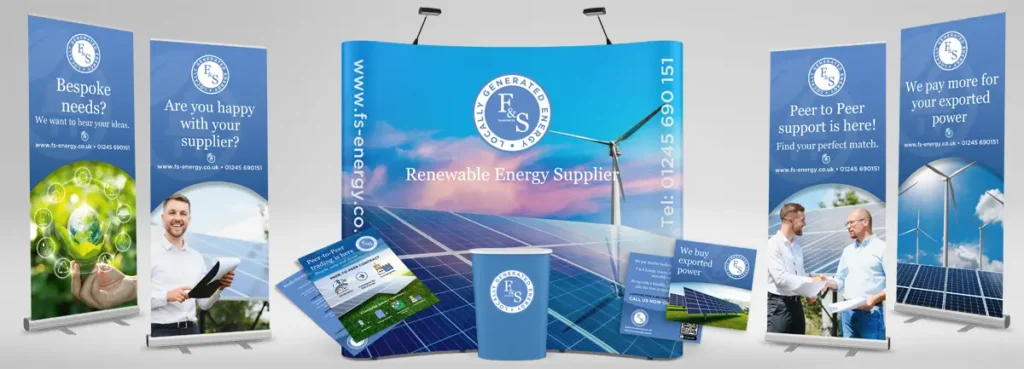Many of us thought Covid-19 spelled the end for in-person events like exhibitions.
But while meeting online was all the rage for a good couple of years while authorities got the pandemic under control, people are desperate to get back out into the real world and pitch their businesses in the flesh once again.
I’ve seen this shift first-hand. I’ve had tonnes of exhibition design enquiries from local companies who now want to make sure they look the part when attending conferences, trade shows, networking events and other corporate occasions.
Recent data backs up this trend, too. In 2023, 6.92 million people attended 1,016 exhibitions, which was a 14% increase from 2022 – plus, statistics show us that the number of trade exhibitions in the UK is now back to pre-Covid levels.
Clearly, then, it’s time to start adding trade shows and exhibitions back into your work calendar. But it’s not simply enough to show up. For maximum impact, you need to make sure all your printed marketing collateral is on point.
What printed marketing materials do you need to make a splash at your next exhibition?
Here are some of the custom printed assets I’d suggest taking with you to every exhibition, and what you’ll need to bear in mind when creating them.
Roller banners
A true exhibition staple, roller banners provide you with a convenient and versatile way to advertise your business in pretty much any setting.
The trick is to make your roller banner designs as eye-catching as possible, without creating visuals that are overcrowded or imbalanced. Always check your roller banners for typos, too – these will be impossible to ignore on such large format items!
Business cards
Yes, I know there are plenty of digital alternatives available these days, but most passers-by will still ask for a business card from you if they are interested in what you have to offer.
Boring, flimsy cards won’t make a great impression on your new contacts, so make sure you invest in a business card design that reflects your branding, makes the most of all available space, and is printed onto thicker, higher quality paper, as this delivers a more premium experience. You could also add an appointment time/date field to your design to encourage follow-ups.
Presentation folders
Personally, I think presentation folders are an underrated asset that can quickly take any pitch from good to great. Practical and professional looking, these folders can be used to house leaflets, brochures, quotes, and other paperwork – and they are a relatively affordable way of ensuring these documents don’t get forgotten by your prospects after a long day of networking.
My advice? Take advantage of the front and back of the folder to showcase your brand. For example, you could mirror a graphic or picture across the folder to create some lovely visual symmetry.
Leaflets and flyers
They might be relatively small, but leaflets and flyers still provide you with a cheap yet powerful way to get your main message across. And because they’re so lightweight, they are easy to transport to and from your exhibition and won’t take up too much room in the car.
You could use your flyers or leaflets to provide an overview of your company and its services or focus on something specific like a new product launch or store opening. Either way, plan your leaflet design carefully to make sure you’re packing in as much information as you can, without making the template look too busy or difficult to read. If you have more to say than your leaflet allows for, why not use a QR code to point the reader in the direction of supporting information on your website or across your social media channels?
Brochures and catalogues
Much more comprehensive than flyers, brochures and catalogues are, in my eyes, the ultimate exhibition takeaway.
The size and scope of your brochure will depend on what it needs to contain. Many of my clients like to opt for a standard 12- or 16-page document that provides their prospects with a top-line overview of who they are and what they do. Others prefer to create full product catalogues with up-to-date pricing information.
Whichever end of the spectrum appeals the most, I’d always recommend investing in the skills of a professional designer – AND an experienced copywriter – before you publish anything. Getting this kind of support will help you organise everything in a logical and appealing way, and reduce the risk of any errors, which can be difficult and costly to correct once your brochure has gone to print.
Branded merchandise and other hand-outs
Aside from the above assets – which are all part of your exhibition starter pack – you can order a range of bespoke items to set your goody bags apart from the rest.
From pens to notepads, keyrings to bottle openers, pretty much any item can be branded up with your logo these days, so have a think what would be the most useful to your audience.
To maximise engagement during and after the exhibition, you could also consider bringing the following with you:
- Product samples and freebies – so prospects have something tangible to take home
- Giveaway prizes – running a competition can help to attract people to your stand
- Touchscreen displays – these provide a more interactive experience
- Discount vouchers and coupons – it’s best to run offers that are exclusive or time-sensitive, so prospects feel they have access to a deal that’s one-of-a-kind
- Branded stationery – pads and post-its are always handy, so are likely to be used by visitors
